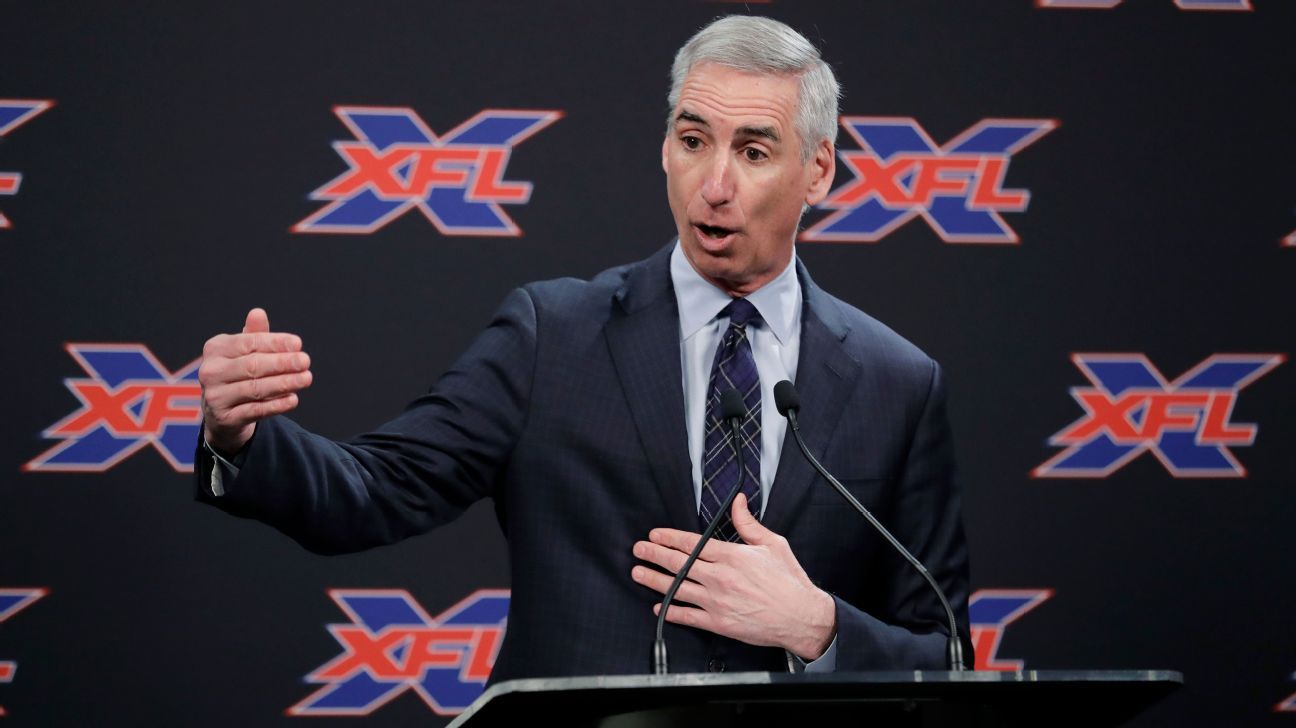The USFL. The World League. The United Football League. The XFL 1.0. And now the Alliance of American Football.
Since the 1970 merger between the AFL and NFL, every attempt at building a large-scale alternative football league has failed. No one has figured it out — and yet they never stop trying.
Next up is XFL 2.0, set to begin play in February 2020. It’s backed by a $500 million investment from owner Vince McMahon, led by an experienced commissioner in Oliver Luck and built on a McKinsey Global Institute research study that found up to 40 million avid fans who crave more football after the NFL season ends.
Industry analysts agree those credentials give the XFL a chance, but the long and one-way history of similar endeavors imposes powerful inertia nonetheless.
“Anybody that thinks that there’s an unquestionable market for spring football is delusional,” said David M. Carter, principal of The Sports Business Group and an associate professor of sports business at USC. “There have been some credible people throwing time and resources at it without the result they anticipated. While you can step back and say that XFL 2.0 — with all of its changes, all of the learnings and the takeaways from over the years to include their own missteps — is positioned far more favorably than anyone else, it’s certainly not a guarantee.”
At the moment, the most prominent alternative football league operating in the United States is The Spring League, a developmental enterprise that has spent the past two years in Austin, Texas. Founder and owner Brian Woods said the league projects $1 million in revenues in 2019, largely because of a “disciplined business model” that requires players to pay a $2,000 fee per season. They do not receive salaries. In return, The Spring League offers a platform for players to be scouted by NFL and CFL personnel.
The XFL, of course, does not consider itself a developmental league in a financial sense and will have much more overhead. Luck, the father of Indianapolis Colts quarterback Andrew Luck, said it will employ about 1,000 people among its league office and eight franchises, including players and coaches. It will have a salary cap “in the ballpark,” Luck said, of $4 million per team. That averages out to about $88,000 per player, based on 45-man rosters, but Luck said they will be paid in tiers that start lower and range up to “significant six figures.”
And initially, the XFL will allow its games to be televised for free. Broadcast rights fees are the largest revenue drivers for the NFL, NBA, NHL, CFL and Major League Baseball. For the NFL, that means $7 billion per year. In 2020, Fox, FS1, ABC and ESPN will broadcast every XFL game. The networks will cover production costs but won’t pay rights fees, a source confirmed. (The AAF, by comparison, actually paid CBS to televise its games this spring. It shuttered in April after a series of events left it without financing.)
McMahon’s investment means the XFL can operate in the short term without television money. But despite the emergence of new revenue sources, most notably in the area of gambling technology, Luck acknowledged it’s “hard to say” if the league can survive long term without a lucrative television deal.
“I sense that Vince [McMahon] will have patience with this league,” Luck said. “I’m not sure he has unlimited patience. Nobody does. He probably realizes you can’t snap your fingers overnight and have a brand. But I certainly think we need to have a sense of urgency, and need to come out of the gate playing good football and not waste any opportunities to build that brand in a positive manner.”
“I certainly think we need to have a sense of urgency, and need to come out of the gate playing good football and not waste any opportunities to build that brand in a positive manner.”
XFL commissioner Oliver Luck on the league’s relaunch
Luck has worked hard to distance the XFL 2.0 from its loud predecessor, which shuttered after one season in 2001. He envisions a league based on quicker-paced games, courtesy of about a dozen innovations he will finalize by the end of August, and a high level of fan engagement. Luck has rejected, for now, some of the more radical on-field adjustments he has been pitched — from outlawing the three-point stance to forcing defensive linemen to line up one yard off the ball — but is prepared to move forward with enough to create a unique style of play.
The possibilities include but are not limited to:
-
A 25-second play clock, to keep the game moving more quickly
-
Speakers in the helmet of each player to minimize the need for huddles
-
Tipping referees to the play call, so they can avoid flags for penalties that don’t affect the play
-
A radical kickoff alignment that moves the kicker back to avoid touchbacks
-
Two-point conversion shootouts in overtime
-
Options for one-, two- and three-point plays after touchdowns
The XFL has partnered with The Spring League to test these suggestions, with at least two more collaborative practice sessions planned for this summer. Luck’s largely traditional hires for head coaching positions — a mix of NFL veterans such as Jim Zorn (Seattle), Winston Moss (Los Angeles) and Pep Hamilton (Washington), along with former college superstar Bob Stoops (Dallas) — will provide a guard rail against gimmicks.
Perhaps the most unique possibility is a rule that would allow two forward passes on one play, provided the first is caught short of the line of scrimmage. That type of modified innovation is a must for any new football league, said Andrew Kline, founder of the investment bank Park Lane, which specializes in sports investments.
“Attention spans in sports have changed,” said Kline, who played college football at San Diego State and was a 2000 draft choice of the St. Louis Rams. “If the XFL is going to work, they’re going to need to modernize the sport in a way that the NFL doesn’t really have to. The NFL is incredibly successful because it’s more than entertainment. It’s more like religion or tribalism. It pulls people in much deeper around whatever the shield is of the team in your local market. There’s a following because of that. They have a tribal selling point, where the XFL is going to need a true entertainment and engagement selling point.”
One innovation that could truly make a splash is a raid of college football, whose players aren’t eligible for the NFL draft until three years after leaving high school. Signing a player like Clemson quarterback Trevor Lawrence (NFL draft-eligible in 2021) would create a buzz, The Spring League’s Woods said, but would also add to the talent level of a league that is going to need it.
“If you really wanted to do something disruptive,” Woods said, “and you really wanted to try to do a standalone bigger venture, my thing would be you would go after younger talent. You would get them for cheaper. You would build the league that way. It would be a very disruptive mechanism for talent procurement that could give a league what they need. You wouldn’t have to necessarily compete with the NFL, or go at those players with NFL-type dollars. You could sign those players for lower dollar figures, guys that have a huge fan base.”
In an interview, Luck acknowledged the possibility but downplayed its scope, estimating there would be between five and 15 such players on XFL rosters in 2020. Rather than antagonize the NCAA, for whom he once held the position of executive vice president for regulatory affairs, Luck said the effort would actually help bolster the organization’s position when challenged on antitrust violations.
“The NCAA would have a pretty good argument,” Luck said, “to be able to say, ‘Hey, you don’t have to go to college to play professional football in the NFL.’ You could spend a year in college and then go to the XFL, and then in a couple of years you could be in the NFL that way.”
Ultimately, Luck said, the XFL will place bets on both its on-field product and engagement with fans. Tentative plans call for providing unique public access to parts of the game that are traditionally sequestered, including pregame talks in the locker room, while also giving fans a role in deciding uniform combinations and halftime entertainment.
Ticket prices aren’t set yet. But Jeffrey Pollack, the XFL’s president and chief operating officer, said “I wouldn’t be surprised” if a family of four could attend for less than $100.
Luck, who lived in Germany for 10 years while working for NFL Europe, used the German word gesamtkunstwerk to describe the all-phases product he hopes to build.
“We’re confident that our brand of football can be unique,” he said. “And so can our entire event, with the access we’re providing, the voice we’re providing to fans, the pricing, all of it. I tell my staff all the time that it’s got to be like a Wagnerian opera — just a complete sensory experience. Football is a critical component, and probably the sine qua non so to speak, but the gesamtkunstwerk has to work for us, too. We want the experience to touch all the senses. That’s ambitious, no doubt about it, but it’s what we want to do.”

